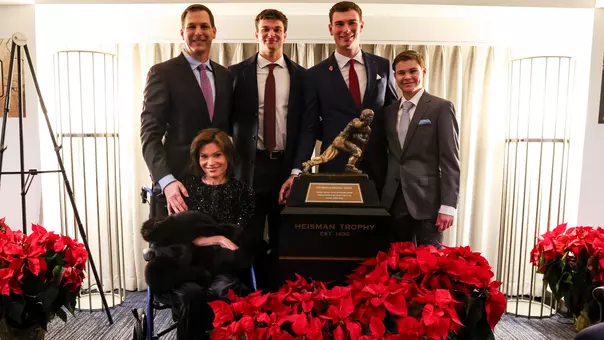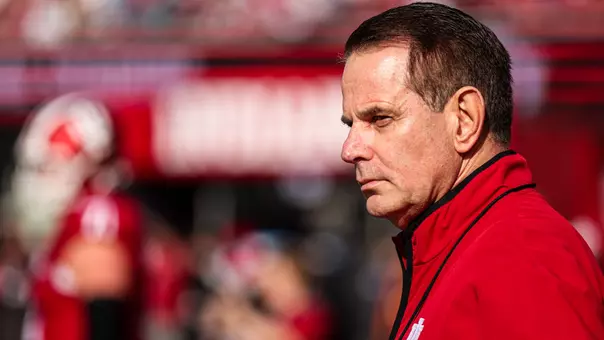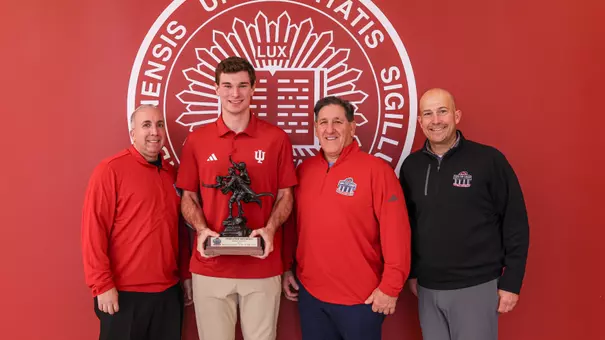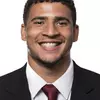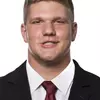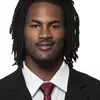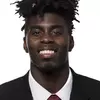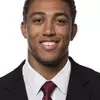Indiana University Athletics

Monday Notebook: Indiana Travels to Virginia
9/4/2017 8:20:00 PM | Football
By: Andy Graham
IUHoosiers.com
BLOOMINGTON, Ind. - This seemed an especially unfair irony.
For the second straight year, a key IU receiver sustained a season-ending injury on his very first play of a campaign.
Hoosiers head coach Tom Allen, during his regular Monday press conference, confirmed that junior Nick Westbrook tore an anterior cruciate knee ligament during the opening kickoff of Thursday's loss to No. 2-ranked Ohio State.
Westbrook led Indiana with 995 yards receiving last fall. The year before that, Simmie Cobbs Jr. had led the Hoosiers with 1,035 receiving yards but broke an ankle on his first snap from scrimmage in 2016.
Having played as a true freshman, Westbrook has a redshirt year available and would qualify for a medical-redshirt designation.
"Unfortunately, he has torn his ACL," Allen said of Westbrook. "Hurt for him. But as we've shared with our team, sometimes life's not fair. Things happen and it's tough.
"He's got a good attitude about it -- just knows that this is a challenge he has to overcome."
Westbrook need look no further than Cobbs for inspiration in that regard.
No player seemed more dominant on the field Thursday than Cobbs, who led all receivers with 11 catches (a career-high) for 149 yards and a touchdown.
PLAYERS OF THE GAME
Cobbs was announced Monday as IU's Offensive Player of the Game. Senior linebacker Tegray Scales, who led all tacklers Thursday with 12, was Defensive Player of the Game while the Special Teams Player of the Game nod went to Chase Dutra.
Redshirt sophomore wide receiver Isaac James, redshirt freshman linebacker Andrew Stamm, true freshman cornerback LaDamion Hunt and true freshman quarterback Nick Tronti were tabbed for last week's Scout Team Awards.
SPECIAL TEAMS SPECIAL
Allen, who regularly emphasizes special teams work during practices, noted that the presence of Westbrook and other key players on the kickoff team was policy.
"It's either important or it's not," Allen said of special teams, implying that attaching value to special teams compelled using valuable personnel. "I think that's program philosophy.
"Did you pay attention to who blocked the punt against Florida State (Saturday night for Alabama)? Their starting tailback. And their backup was on the other side (of the rush). And that's that way, every year."
Allen added that players aspiring to play in the pros also know that special teams experience can help earn and keep NFL roster spots.
"We talk to our guys all the time about it," Allen said. "If they want to make an NFL roster, they better be able to play special teams, if you're a wide receiver. There's a toughness to it.
"(All-American linebacker) Tegray Scales is on the punt team and covering kicks. That's part of it. If you want to be a great football player, you'd better be able to play on special teams."
The special teams duties are spread and shared amongst the Hoosiers talent.
"Now, you've got to be smart about it," Allen said. "(Westbrook) wasn't on all four (special teams). But I believe in your coverage units, especially, you'd better have guys that you trust and (who) can run and make plays.
"If you say (special teams are) a third of the game and you don't put your best players on that, that doesn't really make a lot of sense. We played an Ohio State team that has the luxury of rolling in a lot of their twos on special teams, and there's not much of a drop-off in talent and speed. I haven't coached many places where that was the case and you had the luxury to do that."
KNIGHT TIME?
There was some positive news from the injury front, too, Monday.
Allen reported that junior Brandon Knight, the projected starting right tackle this season who sustained an injury this summer, was back at practice Sunday after missing the opener.
Knight's skill set also lends itself to other spots on the offensive line, so he'll add to the overall depth.
"He's a guy that can play multiple positions," Allen said after acknowledging Knight would likely resurface as a right tackle initially heading into Saturday's game at Virginia. "I think it's about getting the best five on the field. So we're not ready to say where that would be yet.
"You practice him all this week and you monitor his reps and you see how he's progressing and see how it feels after he's practicing, and then you build from there. So you like to systematically bring him back into the fold. I think that's the wise way to do it because you've got to think of the whole season, not just one game.
FAST FROSH?
The most commonly cited adjustment for players elevating from high school to college football is dealing with the increased speed of play.
But then there are guys such as cerebral Indiana center Harry Crider, who as a true freshman played his initial college snaps against an Ohio State defensive front packed with pro prospects.
IU offensive coordinator Mike DeBord said he asked for Crider's impressions following Thursday's setback to the No. 2-ranked Buckeyes, and that Crider replied:
"Coach, it was so much slower than practice."
That isn't commonly heard from true freshmen after their college debut.
"That's a positive," DeBord said. "You want it to 'slow down' for kids when it gets into game time. You want them to know what they're doing, so they can line up and go do it. It's good when, for somebody who is just a freshman, the game was slower than practice.
"Harry's a guy who is, until you get to know him, quiet. Doesn't talk a lot. In fact, we've had to encourage him to talk more when it comes to making calls up front. But he's a confident player and I thought he played well, especially as a freshman going up against that group up front."
So DeBord and the IU staff had no qualms about Crider sharing snaps with starting center Hunter Littlejohn, even in an opener, even against OSU on national television.
"Because he displayed in practice that he can play, and play very well," DeBord explained, "we really didn't hesitate. We had a plan going into it, told him he would play and, again, he did a really good job."
WHEN A PASS IS VIRTUALLY A RUN
Facing that deep and talented Ohio State defensive front helped prompt the Hoosiers to run just 27 times (for only 17 net yards) while throwing 68 passes (completing 42).
But DeBord pointed out that many of the throws were off quick drop-backs, to negate the Buckeyes pass rush, and almost amounted to handoffs. And that several of those plays turned out well for IU.
"Obviously, we've got to block better (for the run)," DeBord said. "(But) we had 18 plays where I actually called runs but we have (options) off those and we ended up throwing the ball. Out of those 18 plays, we completed 11 of them, and averaged over six yards per attempt and over nine yards per completion.
"So as Coach (Allen) talked about, we have to be a better running football team than we were during that game, and will be, but those were some big plays in that game."
Including the 8-yard TD pass from Richard Lagow to Cobbs that put the Hoosiers up, 14-6, in the second quarter.
"We knew going into it that it was going to be hard (to run the ball)," DeBord said. "They have about five first-round draft choices up front. They played seven defensive ends and five inside guys, (so) they're playing about three-deep at four positions. And we basically had six offensive linemen playing.
"And they're really hard to put drives together against. So we knew we were also going to have to throw down the field to take up some of those yards. The first half, I thought we were doing that, and, really, for most of the third quarter, I thought we were doing that. But, as Coach Allen talked about, we just didn't finish."
FIRST ON FIRSTS
Allen said a noticeable difference between Thursday's first half, after which Indiana held a 14-13 lead, and the second was success or lack thereof on first-down snaps.
"It became pretty obvious, as you go through and do the evaluation of it, that we began losing first downs on both sides of the football (after halftime)," Allen said.
"The way we gauged that, and we do competitions in practice throughout spring ball and fall camp where we have first down competition, and the defensive goal is to hold them to three yards or less. And if that happens, then the defense wins. The offense has to get more than three yards; they have to get four yards or more to win those snaps.
"And as you saw the game unfolding, in the first half, we were winning those and getting multiple three-and-outs, defensively, getting first downs on offense. Had 17 of those in the first half. And then in the third quarter, everything started changing."
Allen attributed part of that to the superiority of the OSU depth.
"Another thing that was glaring to me was just depth," Allen said. "You know, just (the) ability to take our starters out, especially defensively, and not have a drop-off in production or in performance by our twos and threes (as a game wears on).
"So that will continue to be addressed."
IUHoosiers.com
BLOOMINGTON, Ind. - This seemed an especially unfair irony.
For the second straight year, a key IU receiver sustained a season-ending injury on his very first play of a campaign.
Hoosiers head coach Tom Allen, during his regular Monday press conference, confirmed that junior Nick Westbrook tore an anterior cruciate knee ligament during the opening kickoff of Thursday's loss to No. 2-ranked Ohio State.
Westbrook led Indiana with 995 yards receiving last fall. The year before that, Simmie Cobbs Jr. had led the Hoosiers with 1,035 receiving yards but broke an ankle on his first snap from scrimmage in 2016.
Having played as a true freshman, Westbrook has a redshirt year available and would qualify for a medical-redshirt designation.
"Unfortunately, he has torn his ACL," Allen said of Westbrook. "Hurt for him. But as we've shared with our team, sometimes life's not fair. Things happen and it's tough.
"He's got a good attitude about it -- just knows that this is a challenge he has to overcome."
Westbrook need look no further than Cobbs for inspiration in that regard.
No player seemed more dominant on the field Thursday than Cobbs, who led all receivers with 11 catches (a career-high) for 149 yards and a touchdown.
PLAYERS OF THE GAME
Cobbs was announced Monday as IU's Offensive Player of the Game. Senior linebacker Tegray Scales, who led all tacklers Thursday with 12, was Defensive Player of the Game while the Special Teams Player of the Game nod went to Chase Dutra.
Redshirt sophomore wide receiver Isaac James, redshirt freshman linebacker Andrew Stamm, true freshman cornerback LaDamion Hunt and true freshman quarterback Nick Tronti were tabbed for last week's Scout Team Awards.
SPECIAL TEAMS SPECIAL
Allen, who regularly emphasizes special teams work during practices, noted that the presence of Westbrook and other key players on the kickoff team was policy.
"It's either important or it's not," Allen said of special teams, implying that attaching value to special teams compelled using valuable personnel. "I think that's program philosophy.
"Did you pay attention to who blocked the punt against Florida State (Saturday night for Alabama)? Their starting tailback. And their backup was on the other side (of the rush). And that's that way, every year."
Allen added that players aspiring to play in the pros also know that special teams experience can help earn and keep NFL roster spots.
"We talk to our guys all the time about it," Allen said. "If they want to make an NFL roster, they better be able to play special teams, if you're a wide receiver. There's a toughness to it.
"(All-American linebacker) Tegray Scales is on the punt team and covering kicks. That's part of it. If you want to be a great football player, you'd better be able to play on special teams."
The special teams duties are spread and shared amongst the Hoosiers talent.
"Now, you've got to be smart about it," Allen said. "(Westbrook) wasn't on all four (special teams). But I believe in your coverage units, especially, you'd better have guys that you trust and (who) can run and make plays.
"If you say (special teams are) a third of the game and you don't put your best players on that, that doesn't really make a lot of sense. We played an Ohio State team that has the luxury of rolling in a lot of their twos on special teams, and there's not much of a drop-off in talent and speed. I haven't coached many places where that was the case and you had the luxury to do that."
KNIGHT TIME?
There was some positive news from the injury front, too, Monday.
Allen reported that junior Brandon Knight, the projected starting right tackle this season who sustained an injury this summer, was back at practice Sunday after missing the opener.
Knight's skill set also lends itself to other spots on the offensive line, so he'll add to the overall depth.
"He's a guy that can play multiple positions," Allen said after acknowledging Knight would likely resurface as a right tackle initially heading into Saturday's game at Virginia. "I think it's about getting the best five on the field. So we're not ready to say where that would be yet.
"You practice him all this week and you monitor his reps and you see how he's progressing and see how it feels after he's practicing, and then you build from there. So you like to systematically bring him back into the fold. I think that's the wise way to do it because you've got to think of the whole season, not just one game.
FAST FROSH?
The most commonly cited adjustment for players elevating from high school to college football is dealing with the increased speed of play.
But then there are guys such as cerebral Indiana center Harry Crider, who as a true freshman played his initial college snaps against an Ohio State defensive front packed with pro prospects.
IU offensive coordinator Mike DeBord said he asked for Crider's impressions following Thursday's setback to the No. 2-ranked Buckeyes, and that Crider replied:
"Coach, it was so much slower than practice."
That isn't commonly heard from true freshmen after their college debut.
"That's a positive," DeBord said. "You want it to 'slow down' for kids when it gets into game time. You want them to know what they're doing, so they can line up and go do it. It's good when, for somebody who is just a freshman, the game was slower than practice.
"Harry's a guy who is, until you get to know him, quiet. Doesn't talk a lot. In fact, we've had to encourage him to talk more when it comes to making calls up front. But he's a confident player and I thought he played well, especially as a freshman going up against that group up front."
So DeBord and the IU staff had no qualms about Crider sharing snaps with starting center Hunter Littlejohn, even in an opener, even against OSU on national television.
"Because he displayed in practice that he can play, and play very well," DeBord explained, "we really didn't hesitate. We had a plan going into it, told him he would play and, again, he did a really good job."
WHEN A PASS IS VIRTUALLY A RUN
Facing that deep and talented Ohio State defensive front helped prompt the Hoosiers to run just 27 times (for only 17 net yards) while throwing 68 passes (completing 42).
But DeBord pointed out that many of the throws were off quick drop-backs, to negate the Buckeyes pass rush, and almost amounted to handoffs. And that several of those plays turned out well for IU.
"Obviously, we've got to block better (for the run)," DeBord said. "(But) we had 18 plays where I actually called runs but we have (options) off those and we ended up throwing the ball. Out of those 18 plays, we completed 11 of them, and averaged over six yards per attempt and over nine yards per completion.
"So as Coach (Allen) talked about, we have to be a better running football team than we were during that game, and will be, but those were some big plays in that game."
Including the 8-yard TD pass from Richard Lagow to Cobbs that put the Hoosiers up, 14-6, in the second quarter.
"We knew going into it that it was going to be hard (to run the ball)," DeBord said. "They have about five first-round draft choices up front. They played seven defensive ends and five inside guys, (so) they're playing about three-deep at four positions. And we basically had six offensive linemen playing.
"And they're really hard to put drives together against. So we knew we were also going to have to throw down the field to take up some of those yards. The first half, I thought we were doing that, and, really, for most of the third quarter, I thought we were doing that. But, as Coach Allen talked about, we just didn't finish."
FIRST ON FIRSTS
Allen said a noticeable difference between Thursday's first half, after which Indiana held a 14-13 lead, and the second was success or lack thereof on first-down snaps.
"It became pretty obvious, as you go through and do the evaluation of it, that we began losing first downs on both sides of the football (after halftime)," Allen said.
"The way we gauged that, and we do competitions in practice throughout spring ball and fall camp where we have first down competition, and the defensive goal is to hold them to three yards or less. And if that happens, then the defense wins. The offense has to get more than three yards; they have to get four yards or more to win those snaps.
"And as you saw the game unfolding, in the first half, we were winning those and getting multiple three-and-outs, defensively, getting first downs on offense. Had 17 of those in the first half. And then in the third quarter, everything started changing."
Allen attributed part of that to the superiority of the OSU depth.
"Another thing that was glaring to me was just depth," Allen said. "You know, just (the) ability to take our starters out, especially defensively, and not have a drop-off in production or in performance by our twos and threes (as a game wears on).
"So that will continue to be addressed."
Players Mentioned
FB: Curt Cignetti - Pre-Heisman Press Conference
Wednesday, December 10
FB: Fernando Mendoza - Pre-Heisman Press Conference
Tuesday, December 09
FB: CFP Quarterfinals (Rose Bowl) - Student-Athlete Press Conference
Monday, December 08
FB: CFP Quarterfinals (Rose Bowl) - Curt Cignetti Press Conference
Sunday, December 07

